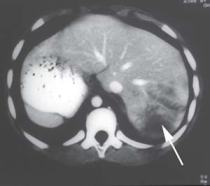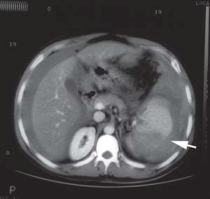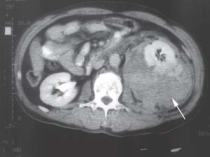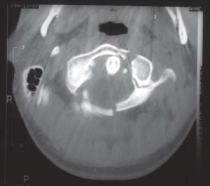|
Abdominal Trauma
The combination of bedside ultrasound and CT scanning has replaced diagnostic peritoneal lavage in the evaluation of blunt abdominal trauma. While the camps of ultrasound and CT advocates are often mutually exclusive, they are very complementary resources. Ultrasound has advantages of being a bedside exam, easily repeated, and sensitive to intra-peritoneal free fluid (a sensitive indicator of need for laparotomy). CT scan is able to detect solid organ injuries, retroperitoneal injuries, and may detect hollow viscus injuries.
In the emergency department, the clinician is often only given a report of CT findings so that you are often at the mercy of the radiologist’s ability. While learning to formally read an abdominal CT is beyond the objective of this chapter, pertinent injuries will be presented in image form. In accepting a report from a radiologist, it
is important to understand the ability and limitations of CT.
- CT scanning is very sensitive to free peritoneal air or pneumothorax, which may be detected on higher abdominal cuts.
- CT is also very sensitive to intraperitoneal fluid or hemorrhage, with a “sentinel clot” often pointing out the source of injury. CT cystogram will aid in detection of bladder injuries.
- CT is very good at detecting solid organ injuries such as splenic fractures or liver fractures, even when not associated with free fluid.
- CT is also the best imaging study for retroperitoneal organs such as pancreas, kidneys or retroperitoneal hemorrhage.
- CT is an excellent study for detecting bony fractures, such as rib, spine or pelvic ring fractures.

Figure: Liver laceration on contrast enhanced CT scan (white arrow).

Figure: Contrast-enhanced CT showing splenic rupture with free fluid also surrounding the liver.

Figure: Left renal fracture with associated hematoma.
- CT cannot adequately rule out hollow viscus injuries, such as small bowel or colon injuries with small perforation. These are often only detected after observation or exploratory laparotomy.
Cervical Spine
- Although not common, cervical spine fractures raise the hairs of emergency physicians due to the potential for catastrophic medical and legal complications.
- Not only are cervical spine fractures potentially unstable and could lead to spinal cord injury, they are often multiple and noncontiguous in up to 16% of patients. This makes the identification of a spinal fracture the beginning of a search for the next one.
- The evaluation of the cervical spine after trauma begins with a clinical evaluation.
Since 800,000 plain radiographs are done each year in the US to evaluate cervical spine injuries, clinical decision guidelines have been derived and prospectively evaluated by the NEXUS study group. This multi-center randomized prospective trial was able to detect 99.6% (sensitivity) of all significant cervical spine fractures. They evaluated patients using the following five criteria:
- No midline tenderness
- No focal neurological deficit
- Normal alertness
- No intoxication
- No painful, distracting injury
If none of these were present they were able to exclude a significant fracture with a negative predictive value of 99.9%.

Figure: CT scan of burst fracture of the ring of C1 (Jefferson fracture).
|
|